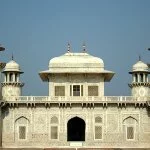Tourist places in Agra
kjohri | Jun 24, 2012 | Comments 0
Agra is a major historical city in the Indian state of Uttar Pradesh. Agra is an old city. It has been referred in the epic Mahabharta as Agrevaṇa. Over time, the city’s name got transformed into much simpler and shorter Agra. Sikandar Lodi, the second ruler of Lodi dynasty, started the building of the city in 1503 and made Agra his second capital city in the year 1506. Sikandar Lodi is credited as the founder of the present day Agra. His son, Ibrahim Lodi, became the ruler after Sikandar Lodi’s death in 1517. Ibrahim Lodi ruled till 1526, till he fought and lost the first battle of Panipat to the Mughal forces of Babur. After 1526, the Mughals took control of the city and started the construction work right away.
Agra got its glory during the reign of Mughal emperor, Akbar the Great. Akbar started major construction work in the fort and shifted the capital to Agra in 1558. Akbar also built Fatehpur Sikri and made it his capital in 1571. Akbar's grandson, Shah Jahan, made the famous Taj Mahal and added more buildings in the Agra Fort. Taj Mahal, Agra Fort and Fatehpur Sikri are all UNESCO World Heritage Sites. Agra, along with Delhi and Jaipur, makes India’s popular Golden Triangle Tour.
Taj Mahal
Taj Mahal is the top tourist attraction in India and is one of the seven wonders of the world. It is a mausoleum built by the Mughal emperor Shah Jahan for his wife Mumtaz Mahal. Mumtaz Mahal died during the birth of her fourteenth child in 1631. Taj Mahal was constructed in the next seventeen years and was completed in 1648. Taj Mahal stands on the bank of the Yamuna river and is built from white marble. Taj Mahal is perfectly symmetrical; it looks exactly the same from any of the four sides. As one enters from the main gateway, Darwaza-i Rauza, one gets a full view of the Taj Mahal, with a longish water pool in front and the mosque and the assembly hall buildings on the two sides. It is, unarguably, one of the most beautiful sights in the world. Taj Mahal is a UNESCO World Heritage Site.
Agra Fort
Agra Fort is located close to the Taj Mahal. Agra Fort was the place where the emperor stayed during the time Agra was the capital and where many important historical events took place. The major construction work at the fort took place during the reign of Mughal emperors Akbar and Shah Jahan during the years 1565-73 and 1627-58 respectively. Agra Fort has beautiful palaces and courts. The places to see in the fort are the Amar Singh Gate, Jahangiri Mahal, Shah Jahani Mahal, Khas Mahal, the golden pavilions, Musamman Burj, Machhi Bhawan, Diwan-I-Khas and the Diwan-I-Aam. Agra Fort is a UNESCO World Heritage Site.
I’tmad-ud-Daula’s Tomb
I’tmad-ud-Daula’s Tomb is made of white marble, with very fine inlay designs and latticework at the facade and interior of the monument. It is sometimes called the Baby Taj
because it is made from white marble and its architectural similarity with the Taj Mahal. There are four grand gateways on the four sides of the monument. I’tmad-ud-Daula’s Tomb is the tomb of Mirza Ghiyas Beg and his wife Asmat Begum. Mirza Ghiyas Beg was conferred the title of I’tmad-ud-Daula, meaning the pillar of the State
, by the Mughal emperor Akbar. Mirza Ghiyas Beg's daughter, Mehrunissa, married Jahangir in 1611, and became famous as Nur Jahan. Nur Jahan arranged the construction of the tomb after her father's death in 1622. The tomb was completed in 1628.
Akbar’s Tomb, Sikandra
Akbar the Great is considered to be the greatest of all Mughal emperors and one of the all time great political icons. Akbar ruled from 1556 to 1605 and consolidated the Mughal empire in India. Akbar’s Tomb is located in Sikandra, at the outskirts of Agra. Akbar started building the tomb in his lifetime around the year 1600. He was laid to rest here after his death in the year 1605. The construction work was completed between 1605-13 by his son Jahangir. The entrance to the tomb is through a grand gateway inspired by the Buland Darwaza at Fatehpur Sikri.
Fatehpur Sikri
Fatehpur Sikri is a historic city located about 37 km west of Agra. Akbar was highly influenced by Shaikh Salim Chishti, the great Sufi saint, who was greatly revered in India. Akbar went to meet Shaikh Salim Chishti at Fatehpur Sikri and Shaikh Salim Chisti predicted that Akbar would get a son. Akbar got a son, whom he named Salim in honor of Shaikh Salim Chishti. Akbar built the city of Fatehpur Sikri and moved his capital here in 1571. The important locations in Fatehpur Sikri are the Jama Masjid mosque complex and the palace complex. The entrance to the mosque complex is via a grand gateway named Buland Darwaza, one of the biggest gateways in the world. Inside the mosque complex, there is Jama Masjid mosque, the tomb of Shaikh Salim Chisti and the tomb of Islam Khan, the grandson of Shaikh Salim Chisti and a general in the Mughal army during Jahangir's reign. Close to the mosque complex is the palace complex. The palace complex has Birbal's palace, Diwan-I-Aam, Diwan-I-Khas, Panch Mahal, Anup Talao and more palaces. Fatehpur Sikri is a UNESCO World Heritage Site.

Random Quotes: Read, search and share quotations.
Filed Under: Travel
